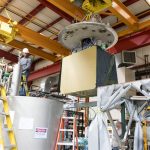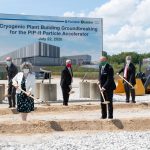Scientists are testing the components and systems for the international Deep Underground Neutrino Experiment, hosted by Fermilab, with other liquid-argon particle detectors. One such detector is ICEBERG, which is over 10,000 times smaller than DUNE will be. ICEBERG’s measurements are providing insight for future neutrino experiments.
Deep Underground Neutrino Experiment
From CERN Courier, Sept. 9, 2020: The first ICHEP meeting since the publication of the update of the European strategy for particle physics covered Higgs and neutrino physics, including results from the CMS collider experiment and the DUNE, NOvA and MicroBooNE neutrino experiments.
From Futurism, Aug. 19, 2020: When an ambitious new Fermilab-hosted experiment called DUNE begins its work, physicists believe they’ll be able to learn a whole lot more about supernova explosions than ever before. That’s because DUNE is expected to be sensitive to an extremely elusive particle called a neutrino that’s blasted far and wide across the cosmos when a star explodes. According to a new paper shared online on Saturday, physicists expect DUNE to scoop up a never-before-detected kind of neutrino and, in doing so, break down why and how stars die in unprecedented detail.
The international Deep Underground Neutrino Experiment collaboration has published a paper about its capability for performing supernova physics. It details the kind of activity DUNE expects in the detector during a supernova burst, how DUNE will know once a supernova occurs and what physics DUNE will extract from the neutrinos. DUNE’s unique strength is its sensitivity to a particular type of neutrino called the electron neutrino, which will provide scientists with supernova data not available from any other experiment.
From Rapid City Journal, Aug. 6, 2020: Crews have begun installing a rock conveyor over U.S. Highway 85 in Lead, South Dakota, for the Long-Baseline Neutrino Facility. The conveyor will bring 800,000 tons of rock from the 4850 level of Sanford Underground Research Facility and deposit them into an open pit mining area that was excavated by the Homestake Gold Mine in the 1980s, making way for the international Deep Underground Neutrino Experiment, hosted by Fermilab.
From Sanford Underground Research Facility, Aug. 4, 2020: The most publicly visible milestone of the Long-Baseline Neutrino Facility’s pre-excavation work, a conveyor system, now extends over U.S. Highway 85 in Lead, South Dakota. Installation of the conveyor is one of a series of infrastructure strengthening projects undertaken to prepare the Sanford Underground Research Facility for its role as LBNF’s far site. Such projects lay the groundwork for the Deep Underground Neutrino Experiment, the most ambitious particle physics experiment on U.S. soil, hosted by Fermilab.
From Black Hills Pioneer, July 22, 2020: Since late 2019, work has been underway on the Long-Baseline Neutrino Facility conveyor system at the Sanford Underground Research Facility in South Dakota. The system will carry more than 800,000 tons of rock excavated from the site of the international, Fermilab-hosted Deep Underground Neutrino Experiment 4,850-feet below the surface. A major milestone for the project was met on July 20 as the 120-foot section of the truss, which will house the conveyor, was erected above the highway.
From CERN Courier, July 7, 2020: A new generation of accelerator and reactor experiments is opening an era of high-precision neutrino measurements to tackle questions such as leptonic CP violation, the mass hierarchy and the possibility of a fourth “sterile” neutrino. These include the international Deep Underground Neutrino Experiment, hosted by Fermilab, and Fermilab’s NOvA and Short-Baseline Neutrino programs.
From Physics, July 2, 2020: Fermilab scientist Marcela Carena is quoted in this overview of the European Strategy for Particle Physics Update. The update outlines a number of current and future priorities, including international neutrino experiments such as the forthcoming Deep Underground Neutrino Experiment, hosted by Fermilab, and the High-Luminosity Large Hadron Collider. It also prioritizes a 100-kilometer circular collider.



